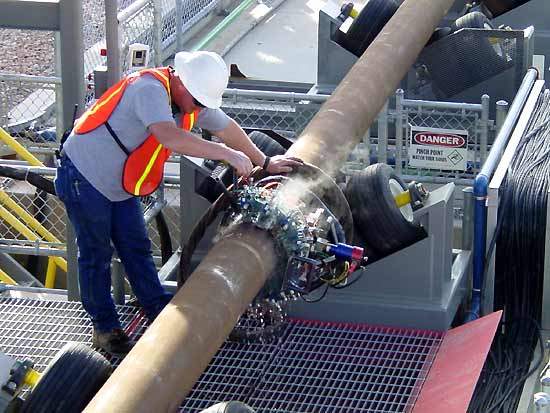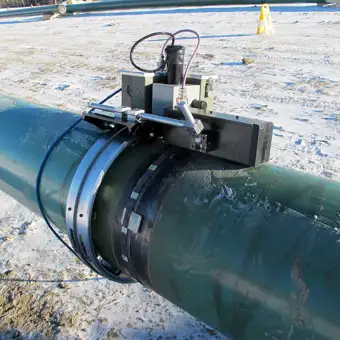Comprehensive Guide to Pipe Welding Assessment: Ensuring Integrity and Safety in Pipe Building and Maintenance
The honesty and safety of pipelines are vital in today's facilities landscape, emphasizing the important role of welding evaluation in pipe building and construction and maintenance. A thorough overview on this subject not only highlights the requirement of analyzing weld high quality but additionally deals with the numerous assessment techniques available, such as radiographic and ultrasonic screening. By comprehending common defects and their effects, stakeholders can carry out best techniques that guarantee compliance and longevity. Nonetheless, the complexities associated with welding evaluation raise important concerns regarding sector criteria and the progressing innovations that may redefine these practices.

Relevance of Welding Evaluation
Welding assessment plays an essential role in making sure the integrity and safety of pipe systems. It works as a basic process that confirms the high quality and reliability of bonded joints, which are usually the most weak spots in pipeline construction. With methodical assessment, assessors can determine prospective problems such as cracks, porosity, and insufficient blend, which might endanger the structural integrity of the pipe.
The significance of welding inspection expands beyond plain conformity with industry criteria; it also safeguards public health and wellness and the environment. Complete inspections can improve the durability of pipeline systems, minimizing the demand for costly repair services and downtime.
Along with guaranteeing safety and security and conformity, welding evaluation promotes a society of quality assurance within companies. By focusing on inspection throughout the welding process, business can construct a track record for reliability and excellence, eventually resulting in raised customer self-confidence and business possibilities (Pipeline Welding Inspection). Therefore, the importance of welding evaluation can not be overstated in the context of pipeline building and construction and upkeep
Key Welding Processes
Numerous welding procedures are used in pipe construction, each with its own benefits and applications. Amongst one of the most commonly used techniques are Shielded Metal Arc Welding (SMAW), Gas Tungsten Arc Welding (GTAW), and Gas Metal Arc Welding (GMAW) SMAW is preferred for its convenience and ability to perform well in various ecological problems, making it ideal for field applications.
GTAW, usually described as Tungsten Inert Gas (TIG) welding, is identified for its capability to create top notch welds with exceptional control over warm input, making it optimal for thin-walled pipelines and stainless steel products. GMAW, or Metal Inert Gas (MIG) welding, provides high deposition rates and is effective for large-scale tasks, usually employed in the fabrication of pipelines in controlled environments.
Furthermore, Submerged Arc Welding (SAW) is used for its deep infiltration and high efficiency, particularly in the building and construction of large-diameter pipelines. Each of these procedures adds to the overall integrity and security of pipe buildings, enabling welders to pick one of the most proper technique based upon product kind, task requirements, and ecological problems. Recognizing these crucial welding processes is necessary for efficient pipe welding evaluation.
Common Problems and Their Impact

Porosity, characterized by little gas pockets trapped within the weld, compromises the material and can bring about leaks. Cracks, which might take place due to thermal tensions or incorrect air conditioning, can result and propagate in structural failure under pressure. Undercutting, where the base steel is worn down along the weld bead, reduces the reliable cross-section of the pipe, enhancing the risk of fracture.
Insufficient combination occurs when the weld steel does not correctly bond with Full Report the base metal, leading to weak areas that might stop working under tension. Slag inclusion, the entrapment of non-metallic product within the weld, can likewise weaken the joint's integrity. Recognizing and addressing these issues early in the building process is vital to guaranteeing the lasting integrity and safety of pipeline systems, thereby guarding both the framework and the atmosphere.
Evaluation Tools and strategies

Aesthetic assessment is the first line of protection, enabling inspectors to determine surface area abnormalities, misalignment, or other noticeable defects. Ultrasonic screening utilizes high-frequency acoustic waves to spot inner imperfections, offering precise depth measurements and characterizing defects without damaging the weld. Radiographic testing utilizes X-rays or gamma rays to generate pictures of the weld, making it possible for the recognition of inner spaces, cracks, or inclusions.
Magnetic fragment screening is particularly effective for finding surface and near-surface discontinuities in ferromagnetic materials. This method involves applying a magnetic field and fine iron particles to the weld, exposing issues through the build-up of fragments at flaw websites.
In enhancement to these techniques, specialized tools such as automated ultrasonic screening devices and digital radiography systems improve inspection accuracy and effectiveness, making certain a comprehensive examination of pipe welds throughout building and upkeep.
Ideal Practices for Conformity
Following ideal practices for compliance in pipe welding examination is crucial for making certain the integrity and security of the facilities. Organizations needs to develop an extensive quality administration system that lines up with industry criteria such as ASME, API, and AWS. This includes establishing detailed welding treatments that specify Visit Website the techniques, materials, and credentials required for welders.
Routine training and accreditation of assessment personnel are vital to preserve high proficiency degrees. Examiners should be familiar with different non-destructive screening (NDT) methods, consisting of ultrasonic screening, radiographic screening, and visual evaluation, to effectively identify potential defects.
Documentation plays an essential function in compliance; preserving exact documents of evaluations, weld treatments, and personnel qualifications aids to guarantee traceability and accountability. Set up audits and evaluations of welding techniques must be performed to identify locations for enhancement and guarantee adherence to established procedures.
Final Thought
To conclude, the execution of strenuous welding examination protocols is extremely important for making certain the honesty and security of pipeline construction and maintenance. By determining defects and employing innovative inspection techniques, organizations can considerably enhance the top quality of bonded joints. Adhering to ideal methods cultivates conformity with market requirements, eventually safeguarding public wellness and preventing environmental threats. Constant renovation in inspection processes will certainly add to the long life and integrity of pipeline systems, underscoring the critical function of welding assessment in the market.
The honesty and safety and security of pipelines are vital in today's framework landscape, underscoring the important function of welding inspection in pipeline building and construction and maintenance. Understanding these crucial welding procedures is necessary for reliable pipeline welding examination.
Adhering to finest methods for conformity in pipe welding evaluation is important for making certain the honesty and safety of the framework.In verdict, the implementation of rigorous welding inspection protocols is critical for guaranteeing the integrity and safety of pipeline building and maintenance. Constant enhancement in inspection processes will contribute to the durability and reliability of pipe systems, emphasizing the crucial role of welding inspection in the sector.